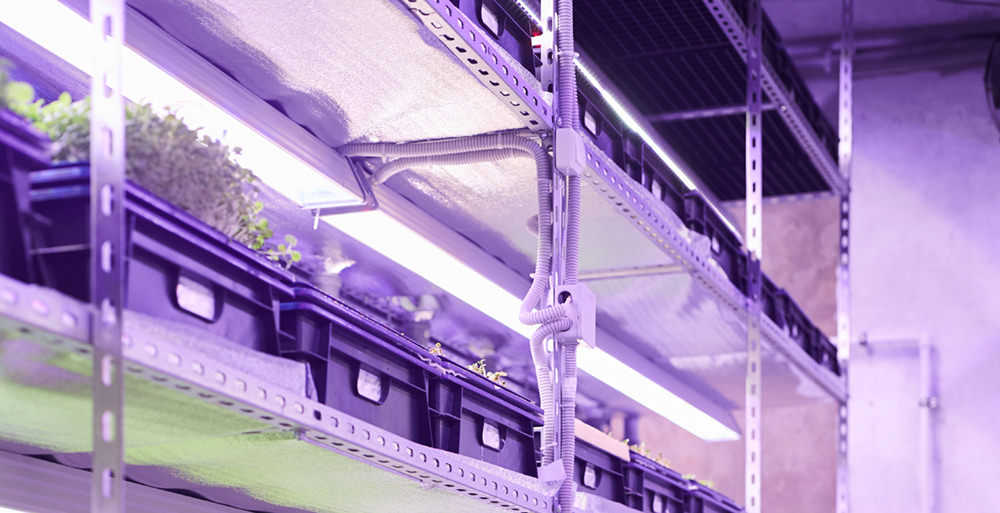How Blue Light Affects Plant Growth
As known, light spectrum is important in plant growth. Whether growing plants in greenhouses, vertical farms, or grow tents, full spectrum LED grow lights are the common selections for most growers. That is because full spectrum LED grow lights contain spectrum in the PAR range, which can improve photosynthesis and balance plant growth. Among spectrum in PAR range, blue light and red light are recognized as the most vital light regions for plant development. Research has shown the absorption of blue and red light by plants could be up to 90%. There are many researches about the effects of blue and red light on plant growth. But how blue light affects plant growth?
What is blue light
Blue light has range of wavelength between 400nm and 500nm. Blue light is within the visible spectrum, which means it is visible by human eyes. It is also the waveband in PAR (Photosynthetic Active Radiation) range. Therefore, blue light is utilized by plants for photosynthesis. Blue light has higher energy than other waveband in PAR range. When days start to get longer, more blue light reaches the surface of the earth. And it initiates the vegetative growth for most plants.

Effects of blue light on plant growth
Blue light affects a wide range of plant processes such as chlorophyll formation and stomata stimulation. It has strong effects on vegetative stage and suppresses extension growth, thus resulting in compact growth. Except for vegetative growth, blue light can also regulate flowering of plants.
Chlorophyll formation
It is well known that blue light affects photosynthesis. That is because blue light provides chlorophyll production in plants. Chlorophyll is a green substance that plant used for photosynthesizing nutrients for growth. It is critical for photosynthesis to produce sugar and carbons. Blue light fits with the absorption peak of chlorophyll. This means chlorophyll use blue light more effectively than red and far-red light. But blue light is less effective in driving photosynthesis than red light. This is because blue light can also be absorbed by carotenoids and anthocyanins. With the lower energy, blue light is not as strong as red light in photosynthesis.
Stimulation of the stomata
Blue light responsible for stomata opening and closing mechanism. Stomata are tiny pores on leaves that control the exchange of water and gas. Opening and closing stomata allow the intake of carbon dioxide and discharge of oxygen. These processes are important for photosynthesis. How far plants open and close the stomata is controlled by the quantity of blue light. High levels of blue light makes plants open their stomata wider, hence accelerating their metabolism. The increased metabolism will accelerate plant growth and development. Thus, greenhouse lighting and indoor lighting usually include the blue light.
Compact growth
Research has shown that plants grown with blue light are normally shorter and have smaller leaves compared to plants grown without blue lights. This is because blue light suppresses extension growth. Plants use a photoreceptor called cryptochrome to see blue light. If there are high levels of blue light, cryptochrome dampens the operation of auxin. Auxin is a plant hormone that regulates plants stem growth. Auxin controls the ‘apical dominance’, making buds to create subsidiary branches instead of getting entwined. Therefore, when plants are exposed to blue light, they create more side stems and stay shorter. By supplementing blue light to greenhouse lighting and indoor lighting, growers are able to regulate plant growth.
Regulate flowering
Blue light can regulate flowering through increasing bud size and timing of flowering. Take cannabis as an example. Flowering is strongly related to plant size and bud size. Blue light can increase the bud size and promote photosynthesis. Plants that accumulate more resources can produce large and dense flowers. To achieve higher yields, blue light is essential for cannabis cultivation. Another way that blue light regulates flowering is to control the flowering time. High intensity blue light can promote flowering of long-day plants and inhibit flowering of short-day plants. However, low intensity blue light does not regulate flowering for most day-length sensitive plants.
Blue light is essential for plant growth. It not only regulated vegetative growth but also flowering. Blue light affects chlorophyll formation, opening and closing mechanism of stomata, extension growth, and flowering. It is usually used with red light to increase photosynthesis. Conjunction with other lights such as green light, far-red light, and UV light have further benefits for plant growth. Therefore, full spectrum LED grow lights are the ideal choices for most plants. To achieve some specific cultivation goals, a customized light spectrum is required. If you need any horticulture lighting solution, don’t hesitate to contact us.

